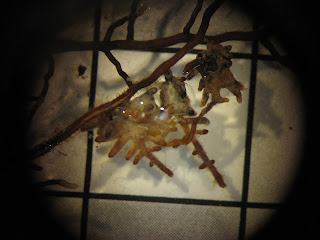Ladies and Gentlemen, your cast, in order of importance:
The Dynamic Duo, a.k.a. the Able-Bodied Assistants, a.k.a. the best money Holly ever spent on scienceThe Microscopy Minion, a.k.a. Holly -- and her bloodshot eyes, too
The Backstory:
Many weeks ago, in a land far, far away, through the mysterious portal of Skype, Holly and her thesis committee members conferred.
"My, what a fine set of data we'll have," they remarked as they contemplated the upcoming harvest of more than five hundred Douglas-fir seedlings. "And we'll have a whole bank of little seedlings, all with their own tiny root system communities of ectomycorrhizal fungi. Whatever shall we do to torture them next?"
 |
| Seedlings waiting to be victimized. Note the adorable straw- and-sticker labeling scheme, which cost S. and I an afternoon. |
"Well," said Holly's advisor, "Let's do something involving community assembly."
"Well," said the NZ team, "Let's do something involving conifer invasion risk."
"Well," said the Stanford crew, "Let's do something cool."
And so the intrepid team designed an exciting experiment with an unfortunately complicated design. The seedlings would be re-planted in randomly assigned pairs, mixing up fungal communities from Douglas-fir plantations, from native beech forests, and from grasslands, which arose from soils collected all across the South Island of New Zealand.
"We'll find out which fungi are better competitors!" said the Stanford crew.
"We'll find out which fungi help Douglas-fir invade!" said the NZ team.
"We'll find out how historical contingency affects community dynamics!" said Holly's advisor.
"We'll create a logistical nightmare..." said Holly, under her breath.
You see, all the seedlings were already in pairs, in their original soil cores. Now, they would have to be gently unpotted and washed without damaging their root systems, measured and processed under the microscope to assess their current complement of fungi, and replanted with new partners. And all this would have to happen as quickly as possible -- ideally, within a few hours -- to minimize strain on the baby trees.
 |
| Step 1: Measure the seedling's height, green height, and color. We also note other plants in the pot. |
Then she spent a few hours doing a quick pilot harvest, finding no fungi on the seedlings, and deciding to abandon the second phase of the experiment.
 |
| Step 2: Pop the soil core out of the PVC pipe. This sometimes requires a great deal of strength! |
The next Monday, Holly's hired helpers arrived. They looked at her, her dirty hands and spotty lab coat, and her greenhouse hodgepodge of trees with some suspicion. They watched and listened patiently as Holly yammered on about proper techniques, the importance of efficiency, and ectomycorrhizal-fungi-as-the-coolest-things-on-Earth. And then they got to work.
 |
| Step 3: Gently, *gently* wash the roots clean! |
By Tuesday, they were washing seedling root systems clean faster than Holly could count them.
 |
| Step 4: Stash the seedlings in a beaker of water. Accumulate massive backlog of washed seedlings and take lunch, while Holly counts frantically. |
 |
| Step 5: Use a 1cm-grid to determine root system size. |
 |
| Step 6: Identify, and count, mycorrhizal root tips. |
And on the following Monday they said, "We can have all this done by tomorrow," and Holly's last conscious thought was, "They're running this show," before she was subsumed into the twin lights of the microscope occulars. They set a new record of 49 pots in a single day. And then Holly slept.
 |
| Step 7: Repot, relabel, water, and stash back in the greenhouse for another year! |

No comments:
Post a Comment